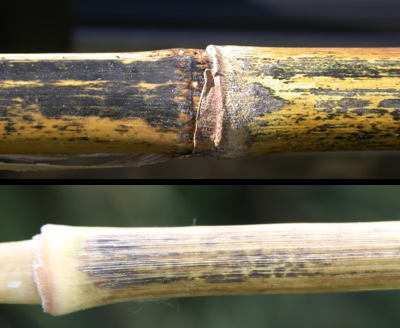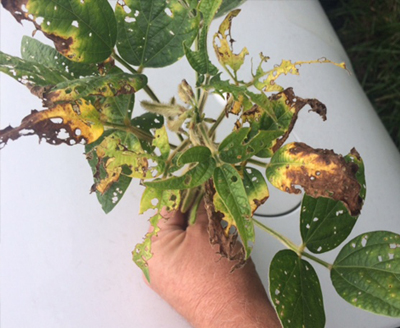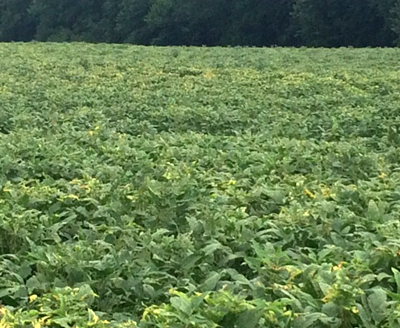
- When top dieback occurs, corn leaves begin to die from the top down prior to physiological maturity.
- Anthracnose stalk rot, boring insects and drought stress can all result in top dieback of corn.
- The causes of soybean top dieback are not clear but nutrient deficiencies, soybean cyst nematodes (SCN) and northern stem canker have all been associated with this disorder.
We provide a review of potential causes of this disorder and implications for management. In this article, we have summarized some of our findings and hope you find this review helpful.
Corn
There are a few factors that can cause top dieback of corn. We typically think of anthracnose stalk rot, as being one of the most common causes but drought stress and insect damage can also be the culprit. When top dieback occurs, corn leaves begin to die from the top down prior to physiological maturity (when natural senescence occurs).If anthracnose is the cause, leaves of affected plants will be yellow, purple or dead and will be scattered throughout the field. Anthracnose will also cause black lesions on the outside of the stalk (Photo 1) at the top of the plant while the inner pith will be rotted and discolored. Selecting hybrids with resistance to anthracnose or with good stalk strength as well as management of foliar diseases with fungicides can reduce the risk of stalk rot development. Once symptoms are observed, harvesting affected fields earlier before plants are lodged can reduce yield losses. When drought and heat stress is the cause, symptoms of leaf death will show up somewhat uniformly across dry areas of the field so this may be a key characteristic for diagnosing the cause. In this case, management includes good agronomic practices such as proper fertilization, drainage management and irrigation if possible to avoid drought stress. Damage from boring insects can also result in top dieback but if you have planted Bt corn, this is unlikely to be the cause. In non-Bt corn, top dieback caused by boring insects will show up in random spots or areas throughout the field instead of uniformly. Bt hybrids with corn borer traits, or if non-Bt, timely insecticide applications can help reduce the risk of top dieback.
Soybeans

Symptoms of soybean top dieback include yellowing and death of leaves in the upper portion of the plant canopy. The edges of affected leaves turn brown and look burnt and the dead tissue falls out (Photo 2). Plants may die prematurely when the disease is severe. Field distribution will be in scattered patches throughout the field (Photo 3). The causes of soybean dieback are not clear but nutrient deficiencies, soybean cyst nematodes (SCN) and northern stem canker have been to blame. Symptoms of top dieback in soybeans can resemble potassium (K) deficiency and although K deficiency shows first on lower leaves, symptoms may progress to the top if deficiency is not corrected. I even came across a few statements indicating that K fertilization has stopped or reduced symptom development of fungal infections associated with top dieback. This is probably due to the plant’s ability to perform their normal physiological and biochemical processes and not to K having a direct effect on any top dieback related pathogens. If a soil test has been done to test for nutrient deficiencies and K levels are within the sufficient range, K deficiency is unlikely the cause. Heavy infestations of SCN combined with stressful growing conditions have also resulted in top dieback symptoms and plant death. In fields where top dieback is observed, SCN is frequently found. Performing a SCN egg count test can provide information of SCN presence and level of infestation in a field. If SCN is the culprit, crop rotation, switching SCN resistant varieties (sources of resistance) and use of seed treatments can lower SCN damage and egg numbers. Lastly, a paper from 1981, confirmed that Diaporthe phaseolorum var. caulivora (the causal fungus of northern stem canker) can cause late season dieback of soybeans. This fungus survives on crop residue so crop rotation and tillage are important to reduce the inoculum but resistant varieties are also available. A more detailed article on stem canker was published in September 13, 2017 and can be found in the fssystem.com 
Photo 1. Anthracnose lesions on corn stalk. (Source GROWMARK, Inc.)
Photo 2. Symptoms of soybean top dieback (Source: Evergreen FS)
Photo 3. Field distribution of soybean top dieback (Source: Evergreen FS)